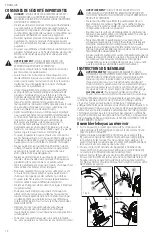
ENGLISH
4
Pump Disassembly & Reassembly
NOTICE:
Remove pump from tank prior to
disassembly.
1. Inspect gasket. If worn or damaged, remove and replace.
(Fig. N)
2. To remove pump cap from pump barrel, squeeze the tabs
on the cap and pull away from barrel. (Fig. O)
3. Inspect o-ring. If worn or damaged, remove and replace.
Lubricate o-ring with petroleum jelly. (Fig. P)
4. Inspect check valve in bottom of barrel. If worn or
damaged, remove and replace by pressing into hole in
bottom of barrel. (Fig. Q)
5. Insert the pump handle assembly into the barrel. Align
the tabs of the pump cap with the rectangle cutouts
on the barrel. Push cap into place until the cap snaps
securely into position. (Fig. R)
Nozzle Maintenance
1. If nozzle clogs, remove and disassemble the nozzle
assembly.
2. Clean the openings of any obstructions and reassemble.
Shut-off Maintenance
NOTICE:
Always depressurize sprayer before
maintenance by activating shut-off and spraying
contents out.
1. Unscrew the hose nut (1) from the shut-off assembly (3).
2. Remove the hose with attached filter (2) from the shut-off
assembly (3).
3. Clean any debris from inside the shut-off assembly (3), or
the filter (2) by rinsing with cool, clean water.
4. Reassemble the components as shown and tighten all
connections securely.
1
2
3
Fig. S
3. Empty any remaining liquid according to the product
disposal directions.
4. Follow the
Cleaning
instructions.
Cleaning Instructions
WARNING:
RISK OF PERSONAL INJURY DUE TO
CHEMICAL EXPOSURE. Use the appropriate Personal
Protective Equipment (PPE) as recommended by the
chemical manufacturer and/or refer to the chemical
Safety Dada Sheet (SDS) of the chemical being used.
This includes at least goggles, gloves, and protective
clothing.
1. Remove the pump as described in the
Finish
section.
2. Remove all unused chemicals from the tank.
3. Store or dispose of any unused chemicals as instructed
by the chemical manufacturer due to the potential for
environmental damage from a spill or leak, and/or refer to
disposal criteria referenced in the Safety Data Sheet (SDS).
4. Fill the tank with cool, clean tap water. Replace the pump
and tighten securely.
5. Agitate the tank to rinse the chemical from the tank wall
and pump.
6. Remove the pump and empty the contents into gravel
or bare soil where any trace amounts of chemical will
have no effect.
7. Refill the tank with cool, clean tap water.
8. Make sure the pump is free of dirt or debris and reinstall
into the tank. Tighten securely.
9. Pressurize the tank as described in the
Pressurizing
section.
10. Direct the nozzle away from you in a safe direction,
where any remaining chemical in the hose will have
no effect, and activate the shut-off for at least 30 seconds
to clean the hose and shut-off.
11. Release pressure as described in the
Release Tank
Pressure
section.
12. Remove the pump and empty the contents into gravel
or bare soil where any trace amounts of chemical will
have no effect.
13. Repeat steps 7 - 12 until thoroughly cleaned.
Sprayer Storage
1. Sprayer tank should be hung upside down, with the
pump removed.
2. Do not store or leave any solution in the tank after use.
3. Store in a warm, dry location out of direct sunlight.
4. Keep the sprayer and all chemicals out of the reach of
children
MAINTENANCE INSTRUCTIONS
WARNING:
RISK OF PERSONAL INJURY AND/OR
PROPERTY DAMAGE DUE TO CHEMICAL EXPOSURE.
Always ensure that all chemical has been removed
from the sprayer and the sprayer has been cleaned
prior to performing any maintenance.
WARNING:
RISK OF PERSONAL INJURY. Always
release pressure from the sprayer prior to performing
any maintenance. Disassembly of a sprayer that is still
pressurized may result in the high speed ejection of
components.
Pump Lubrication
At least once per season the o-rings in the pump should be
cleaned and lubricated using petroleum jelly. Heavy use
may require more frequent cleaning and lubrication.
Fig. N
Fig. O
Fig. P
Fig. Q
Fig. R






































